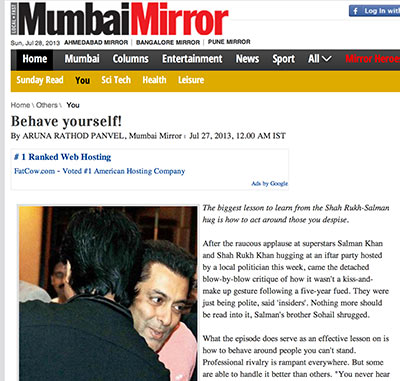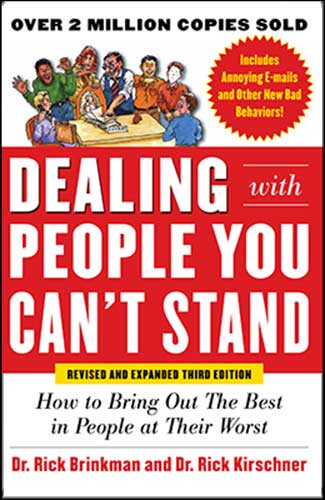Greetings Conscious Communicator, Here's some important info about Relatives...
http://vimeo.com/80228035
DOWNLOAD YOUR FREE RELATIVES AUDIO SEMINAR HERE
Greetings Conscious Communicator, Here's some important info about Relatives...
http://vimeo.com/80228035
DOWNLOAD YOUR FREE RELATIVES AUDIO SEMINAR HERE
Greetings, This is a Relaxation / Hypnotic audio that is designed to both de-stress you and diffuse your triggers with Relatives. ** Watch the important video instructions below. **
It is designed to be listened to with eyes closed, laying down or sifting. More in the video.
http://vimeo.com/71766128
Dr. Rick Brinkman gives you the secret strategy to get people out of whining and into problem solving. http://vimeo.com/73667665
Dr. Rick Brinkman and his grad assistant Neelix, explain why when people do communication training together, they reinforce each other into positive behaviors and the results are exponential. They also talk about the December training opportunity. (1 min) http://vimeo.com/79059269

From my experience, here’s a list of the 10 most unwanted communicators:
The Tank
The Sniper
The Grenade
The Know-It-All
The Think-They-Know-It-All
The Yes person
The Maybe person
The Nothing person
The No person
The Whiner
When people ask who the most difficult person is, I know that they’re secretly hoping I’ll tell them that the most problematic behavior is, in fact, the one exhibited by their #1 “problem” person. After all, it would validate that they are dealing with a jerk … and that they are not responsible for the problem.
But the truth is that difficulty is in the eye of the beholder: If you don’t know how to handle a behavior, it will be challenging for you. Because everyone reacts to thorny people differently, the behaviors that drive one person crazy won’t affect another person at all.
I recently spoke for a group of 75 people, 74 of whom were attending to learn how to deal with one “Tank” vice-president. A lone dissenter stood up and told her colleagues, “I don’t see what the problem is you people have with him. He’s a no-brainer to deal with.” Because she was wired differently than the rest, his behavior didn’t annoy or intimidate her.
Everyone has some skill handling certain behaviors. Other behaviors make us absolutely crazy because we’re missing the knowledge and/or attitude needed to successfully deal with the “problem” behavior. That’s where it pays to be a Conscious Communicator. By paying attention to what works — and what doesn’t — in human interaction, you can expand your communication skill set and achieve greater harmony with the people around you.
Which Behaviors Are Difficult for You?
In general, people who exhibit Get-It-Done behaviors are driven crazy by whiny or wishy-washy behaviors, because neither of these behaviors produces results. Whiners get nothing done because they are too busy wallowing in self-pity. Likewise, wishy-washy people accomplish little because they are fabulous at making commitments — and not keeping them. On the other hand, people who are friendly and desire harmony are intimidated by aggressive Tank-style behavior. People who are more expressive and emotional are driven crazy by Nothing people, who tend to be quiet and withdrawn, and vice versa.
Avoid or Play Nicely? Avoidance can be a valid strategy when dealing with people exhibiting difficult behaviors. After all, dealing with a difficult behavior takes a lot of work, so you must ask yourself if the relationship or job is worth the energy you must spend dealing with the problem person. If it’s not worth the price, it might be easier to leave the situation … or to get the other person to leave.
Unfortunately, leaving or otherwise avoiding a situation is not always possible. Perhaps you don’t want to quit your job … or your problem person is a close relative. In this scenario, you have to change your attitude, a process that starts by focusing on how you would benefit by changing your own behavior or attitude. When you successfully learn how to handle a difficult behavior, you’re doing yourself a favor — not only this time, but every time you encounter that behavior.
For people in leadership positions, learning to successfully deal with all problem behaviors is extremely beneficial. A leader’s job is to bring out the best in others, as well as to orchestrate a successful working environment, which means you can’t afford to have a difficult behavior destroying the morale or productivity of your team. Over the course of a career, you will work with all different types of people. Knowing how to deal with all of them gives you a competitive edge over colleagues who don’t practice Conscious Communication.
I have made the big time! ;-)Actually the Mumbai Mirror is part of the prestigious Times of India group. I am honored to help. Full Article Here

http://vimeo.com/69394371
 A study found that by reacting to a person, rather than ignoring them, causes more stress and distraction that lasts far longer than the actual event.
I was honored to be a communication expert in this article at Woman's Health where the theme is "when to hold'em, when to fold 'em" or when do you do something about a behavior and when do you let it go. In this article I answer the age old questions of what to do if:
A study found that by reacting to a person, rather than ignoring them, causes more stress and distraction that lasts far longer than the actual event.
I was honored to be a communication expert in this article at Woman's Health where the theme is "when to hold'em, when to fold 'em" or when do you do something about a behavior and when do you let it go. In this article I answer the age old questions of what to do if:
The situation: A woman cuts you in line at Starbucks
The situation: Your boyfriend / husband leaves his dirty clothes strewn over the floor for the hundredth time
The situation: Someone keeps texting in the middle of a movie
The situation: While you’re walking down the street, a dude hollers, “Hey baby, lookin’ good!”
The situation: Your slacker coworker asks you to help him finish his quarterly report
The situation: A close friend shows up an hour late to your birthday dinner
The situation: During holiday dinner, Uncle Marvin says, “You look really tired.”

Though we are associated with "Difficult People our book is not about personality types. We find it more effective to think in terms of behavior and what motivates it. Why when under stress does one person whine, another attack, another withdraw, while others go passive aggressive. There are four factors that influence where people go in our Lens of Understanding human behavior.
1. Organizational culture
2. Job function
3. The people around us
4. Personal programming
Organizational culture is the behaviors both good and bad, that are considered acceptable and forbidden.
When I presented seminars for IBM's leadership series and talked about the Grenade tantrum, consistently half the IBM’ers in the room would say “I can’t imagine somebody doing that at work.” While the other half of the room would say, “Oh yes they do!”
The difference was the half but couldn't imagine it were IBM’ers who were always at IBM. The half that said “Yes they do”, were IBM’ers who get sent to someone else's facility. They realized their corporate culture didn’t tolerate grenade tantrums. However, Tank (attack) and Know-it-all run free as protected species.
I performed some programs for Chevron and people told me they have a term called the “Chevron Yes”. What that means is you are pleasant and agreeable on the surface but that doesn't mean you really agree or will follow through.
A second factor is job function. I noticed professional nurses can easily get into whining because often they are on the front line knowing what needs to be done, but trumped by a Tank or Know-it-all doctor and limited by a hospital bureaucracy. The result of that equation is a feeling of being helpless. Helpless is the root of whining. (Hopeless the root of negativity.)
A third factor that influences behavior is the people around us. Whining, Negativity and Sniping are virulent and spread like the flu and before you know it everyone is doing it. Have you ever noticed how one department can have an ongoing sniping relationship with another department? The other difficult behaviors do not replicate, but they still cause problems. Put a Know-it-all on a team of people and watch everyone turn into Nothing people who won’t speak up or contribute at meetings.
Your relationship can also be a factor. If a colleague attacks you may stand up for yourself. If your boss attacks, you may be more passive.
And of course each of us individually comes wired with some tendencies to where we go in the lens when at work.
To prevent and move people into the “Cooperation Zone” of the lens requires:
1. Recognizing where people are behaviorally in the Lens of Understanding.
2. Recognizing the factors influencing behavior of job function, organizational culture and team members.
3. Knowing the strategy to transform their behavior. Communication is like a phone number. You need all digits and you need them in the correct order. There is a specific strategy to move people back into the Cooperation zone.
[hana-flv-player video="http://rickbrinkman.com/blog_videos/AMNW.flv"width="480" height="360" description="" player="4" autoload="true" autoplay="false" loop="false" autorewind="false" /]
Dr. Rick Brinkman, co-author of the international best selling McGraw-Hill book, Dealing With People You Can't Stand, How to Bring Out the Best in People at Their Worst, appears on Portland, Oregon's AM Northwest to talk about dealing with relatives.

JUST RELEASED: The Chinese long form translation of the third version of Dealing with People You Can't Stand, How to Bring Out the Best in People at Their Worst.
Here is the Lens of Understanding.

Angela Murray, the second defendant in my father's murder pleaded guilty to Murder 2. She can't be convicted on Murder 1 since the other guy was already found guilty of that. My understanding is Murder 1 is "intent to kill" while Murder 2 is an event that happens within another crime but the defendant may not have been the one to actually do the killing. However, she is the one who had the relationship with my father and betrayed him.
Tomorrow she will be sentenced to 16 years to life. That means she is eligible for parole after 16 years, but there are no guarantees she may ever get out.
Here is my statement to the court that will be played tomorrow at her sentencing. You get to see it today.
(For details Google "Guido Felix Brinkmann")
Synchronistically I am in NYC and will be only a few blocks away performing a seminar so I made this 3 minute video: This video is in FLASH. For an iOS compatible version here.
[hana-flv-player video="http://rickbrinkman.com/statement/Statement-to-the-Court-Angela.flv" width="480" height="356" description="Dr. Brinkman Statement to Court" player="4" autoload="true" autoplay="false" loop="false" autorewind="false" /]
Forbes featured the new third version of our book, Dealing with People You Can't Stand, How to Bring Out the Best in People at Their Worst. You can read the article here: http://www.forbes.com
 Time Magazine Business online quotes our book Dealing With People You Can't Stand, How to Bring Out the Best in People at Their Worst (Brinkman & Kirschner, 2012 McGraw-Hill) with advice on how to deal with tough behaviors in the business world.
Visit the Time Article here.
Time Magazine Business online quotes our book Dealing With People You Can't Stand, How to Bring Out the Best in People at Their Worst (Brinkman & Kirschner, 2012 McGraw-Hill) with advice on how to deal with tough behaviors in the business world.
Visit the Time Article here.
I'm proud to announce the release of our book Dealing with People You Can't Stand, How to Bring Out the Best in People at Their Worst (Brinkman & Kirschner, 1994, 2003, 2012 McGraw-Hill). The original came out in 1994 and has sold over 2,000,000 copies with translations in 20 languages. In the new version we added three behaviors: Meddlers, Martyrs and Judges. We also added to Whiners and No people and created a new lens of understanding. For a free color PDF download of the new Lens visit: DealingWithPeople.com.
